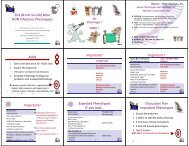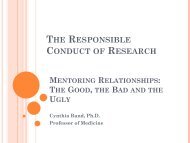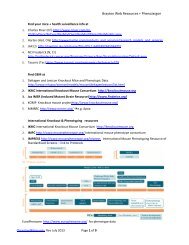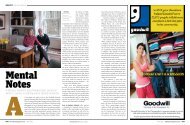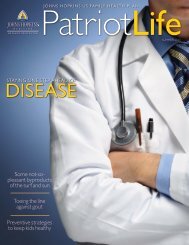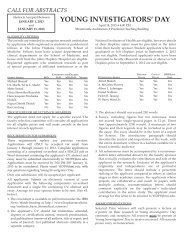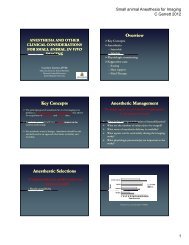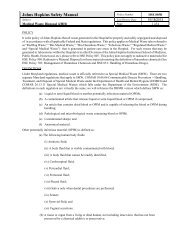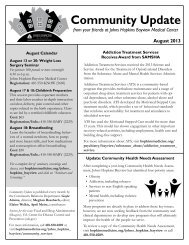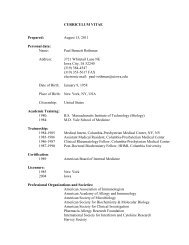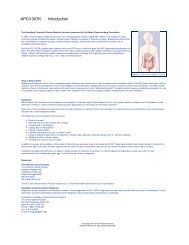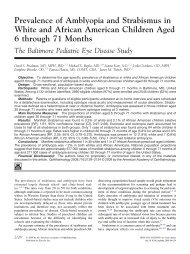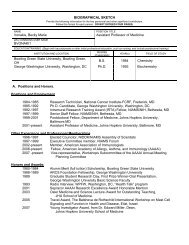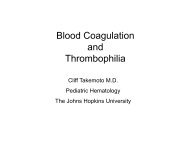Hazard Warning Signage-HSE803 - Johns Hopkins Medical ...
Hazard Warning Signage-HSE803 - Johns Hopkins Medical ...
Hazard Warning Signage-HSE803 - Johns Hopkins Medical ...
You also want an ePaper? Increase the reach of your titles
YUMPU automatically turns print PDFs into web optimized ePapers that Google loves.
<strong>Johns</strong> <strong>Hopkins</strong> Safety Manual Policy Number HSE 803<br />
Subject: Last Review Date 09/20/13<br />
<strong>Hazard</strong> <strong>Warning</strong> <strong>Signage</strong> Page 1 of 7<br />
POLICY<br />
It is the policy of <strong>Johns</strong> <strong>Hopkins</strong> that all laboratories be posted with hazard warning signage which restricts entry<br />
into laboratories to authorized personnel only. The hazard warning signage shall be the approved signage system for<br />
<strong>Johns</strong> <strong>Hopkins</strong>. The Department of Health, Safety and Environment and the Joint Committee on Health, Safety and<br />
Environment shall approve appropriate hazard warning signage for <strong>Johns</strong> <strong>Hopkins</strong>.<br />
The <strong>Johns</strong> <strong>Hopkins</strong> hazard warning signage must be posted at the entrance to all laboratory areas, and include the<br />
name and off hours phone number of two individuals who are familiar with the operations of the laboratory. This<br />
information is necessary for proper emergency response. The hazard warning signage shall also indicate known<br />
hazards which are present in the laboratory. See the enclosed <strong>Hazard</strong> <strong>Warning</strong> Label guidelines for the description<br />
of common hazards.<br />
RESPONSIBILITIES<br />
Principal Investigators/Lab Managers<br />
Health, Safety and Environment<br />
All Staff<br />
Provide the names and 24-hour phone numbers for at least two<br />
emergency contact persons on the hazard warning signage.<br />
Maintain current emergency contact information on all hazard<br />
warning signage.<br />
Maintain current hazard identification on all hazard warning<br />
signage.<br />
Keep hazard warning signage conspicuously posted on all laboratory<br />
entrances.<br />
Provide <strong>Johns</strong> <strong>Hopkins</strong> approved hazard warning signage to<br />
principal investigators and lab managers.<br />
Monitor hazard warning signage for accuracy and completeness<br />
during environmental surveys<br />
Obey hazard warning signage, and refrain from entering areas<br />
posted as authorized personnel only if such authorization has not<br />
been provided.<br />
HAZARD WARNING LABELS<br />
When posted this Restricted Area label signifies admittance only to faculty, staff and<br />
students whom the Primary Investigator or Laboratory Supervisor have pre-authorized<br />
to enter.<br />
Rooms or areas where human body fluids or unfixed cell tissue, or organ cultures are<br />
handled for research, diagnosis, shipment and equipment used for research or<br />
diagnosis with specimens containing potentially infectious materials (PIMS) shall<br />
be conspicuously posted with the Biohazard Symbol and the Caution - Potentially<br />
Infectious Materials warning.
<strong>Johns</strong> <strong>Hopkins</strong> Safety Manual Policy Number HSE 803<br />
Subject: Last Review Date 09/20/13<br />
<strong>Hazard</strong> <strong>Warning</strong> <strong>Signage</strong> Page 2 of 7<br />
Laboratories and support areas where viral, bacterial, rickettsial, fungal, and parasitic<br />
agents requiring containment at biosafety level (BSL) 2 or greater are used or stored<br />
shall be conspicuously posted with the Caution - Infectious Agents sign.<br />
Animal rooms and other containment areas which house animals deliberately infected<br />
with agents requiring BSL 2 (or greater) containment shall be posted with the<br />
Biohazard Symbol and the Caution - Infected Animals warning.<br />
This Biosafety Level 2 (BSL 2) label, with the appropriate biohazard warning,<br />
designates a containment level that meets the BMBL recommendations for BSL 2<br />
work practices, safety equipment and facility design.<br />
This Biosafety Level 3 (BSL 3) label, with the appropriate biohazard warning,<br />
designates a containment level which meets the BMBL 1 recommendations for BSL 3<br />
work practices, safety equipment and facility design.<br />
Each area or room in which radioactive materials are used or stored or where<br />
radioactive wastes are accumulated or stored shall be conspicuously posted with a<br />
sign bearing the radiation symbol and the Caution - Radioactive Materials<br />
warning.<br />
1 Biosafety in Microbiological and Biomedical Laboratories, U.S. Department of Health and Human Services,<br />
Public Health Service, Centers for Disease Control and National Institutes of Health, HHS Publication No. 21-<br />
1112, Fifth edition, Revised December 2009.
<strong>Johns</strong> <strong>Hopkins</strong> Safety Manual Policy Number HSE 803<br />
Subject: Last Review Date 09/20/13<br />
<strong>Hazard</strong> <strong>Warning</strong> <strong>Signage</strong> Page 3 of 7<br />
Each radiation area (any area, accessible to faculty, staff or students in which there<br />
exists radiation at such levels that a major portion of the body could receive in any 1<br />
hour a dose in excess of 5 millirem or in any 5 consecutive days a dose in excess of<br />
100 millirem) shall be conspicuously posted with the Caution - Radiation Area sign.<br />
Each high radiation area (any area accessible to faculty, staff or students in which<br />
there exists radiation at such levels that a major portion of the body could receive in<br />
any one hour a dose in excess of 100 millirem) shall be conspicuously posted with the<br />
Caution - High Radiation Area sign.<br />
All rooms or areas, accessible to faculty, staff or students in which there exists a<br />
potential for exposure to ultraviolet light above the NIOSH published recommended<br />
exposure limit (REL) for occupational exposure. At 254nm, the wavelength for<br />
ultraviolet germicidal irradiation (UVGI), the REL is 0.006 joules per square<br />
centimeter (0.006 J/cm 2 ). The permissible irradiance for an 8 hour workday exposure<br />
is
<strong>Johns</strong> <strong>Hopkins</strong> Safety Manual Policy Number HSE 803<br />
Subject: Last Review Date 09/20/13<br />
<strong>Hazard</strong> <strong>Warning</strong> <strong>Signage</strong> Page 4 of 7<br />
The carcinogen symbol is posted when chemicals, classified as known human<br />
carcinogens by the National Toxicology Program (NTP), International Agency for<br />
Research on Cancer monographs (IARC) and OSHA, are used or stored in the<br />
laboratory or work area.<br />
Rooms and areas used as dedicated chemical storage rooms and/or dispensing rooms<br />
should display the Chemical Storage Area sign.<br />
Separate rooms, cabinets or areas where corrosives (concentrated acids or bases) in<br />
excess of one (1) day's supply are stored shall be conspicuously posted with the<br />
Caution - Corrosive Materials sign.<br />
This toxic chemicals sign shall be posted in all areas or rooms where hazardous<br />
chemicals with an American Conference of Governmental Industrial Hygienists<br />
(ACGIH) threshold limit value (TLV) of 5 ppm or less are used or stored. (A list of<br />
chemicals with a TLV < 5 ppm can be found in the <strong>Johns</strong> <strong>Hopkins</strong> Safety Manual)
<strong>Johns</strong> <strong>Hopkins</strong> Safety Manual Policy Number HSE 803<br />
Subject: Last Review Date 09/20/13<br />
<strong>Hazard</strong> <strong>Warning</strong> <strong>Signage</strong> Page 5 of 7<br />
This toxic gas sign shall be posted in all areas or rooms where toxic gases with an<br />
American Conference of Governmental Industrial Hygienists (ACGIH) threshold<br />
limit value (TLV) of 10 ppm or less are used or stored. A partial list of these toxic<br />
gases and their TLV or ceiling level (C) is below:<br />
Arsine (0.05 ppm)<br />
Hydrogen sulfide(10 ppm)<br />
Boron trichloride (1 ppm)<br />
Methyl mercaptan(0.5 ppm)<br />
Boron trifluoride (1 ppm C) Monomethylamine(5 ppm)<br />
Butadiene (10 ppm)<br />
Nitrogen dioxide(3 ppm)<br />
Chlorine (1 ppm)<br />
Phosgene(0.1 ppm)<br />
Cyanogen (10 ppm)<br />
Phosphine(0.3 ppm)<br />
Diborane (0.1 ppm)<br />
Silane(5 ppm)<br />
Dimethylamine(5 ppm)<br />
Silicon tetrafluoride(0.1 ppm)<br />
Hydrogen bromide(5 ppm) Sulfur dioxide(2 ppm)<br />
Hydrogen chloride(5 ppm C) Sulfur tetrafluoride(0.1 ppm C)<br />
Hydrogen fluoride(3 ppm C) Trimethylamine(5 ppm)<br />
Hydrogen selenide(0.05 ppm)<br />
All rooms and areas, accessible to faculty, staff or students which contain, unguarded<br />
(exposed, open) electrical equipment in excess of 600 volts shall be conspicuously<br />
posted with the Caution - High Voltage sign.<br />
All rooms or areas, accessible to faculty, staff or students with exposed (open)<br />
electrical systems or live parts less than 600 volts shall be labeled with the Caution -<br />
Electrical <strong>Hazard</strong> sign.<br />
This sign indicates that eating, drinking, smoking, handling of contact lenses, and<br />
applying cosmetics are not permitted in the posted work area because there is<br />
reasonable likelihood of exposure to hazardous chemicals, radioactive materials or<br />
potentially infectious materials.
<strong>Johns</strong> <strong>Hopkins</strong> Safety Manual Policy Number HSE 803<br />
Subject: Last Review Date 09/20/13<br />
<strong>Hazard</strong> <strong>Warning</strong> <strong>Signage</strong> Page 6 of 7<br />
This eye protection required label shall be posted in all areas, accessible to faculty,<br />
staff or students, in which there is a reasonable probability of exposure to hazardous<br />
chemicals, potentially infectious agents or physical hazards which could result in<br />
injury. Eye protection shall be worn at all times in these areas when exposure<br />
potential exists.<br />
Each area or room, accessible to faculty, staff or students, in which there is a potential<br />
for noise exposure which may equal or exceed an 8-hour time-weighted average<br />
sound level (TWA) of 85 dBA. (OSHA standard 1910.95) shall be posted with the<br />
hearing protection required label.<br />
This protective clothing required sign shall be posted when work conditions require<br />
specific protective clothing that is beyond the standard laboratory coat. Personal<br />
protective equipment selected for this work area shall be based on an evaluation of the<br />
task specific conditions and the hazards and potential hazards that are encountered.<br />
This Infectious Agents Sticker shall be posted on all rooms or areas in which BSL 2<br />
or 3 organisms are present including animal holding rooms and animal isolation<br />
rooms or cubicles, animal procedure rooms and research or diagnostic laboratories.<br />
The principle investigator or laboratory manager is responsible to list the BSL 3<br />
organisms present on the posted space. Only the following organisms are exempt<br />
from identification: Non-cytotoxin-producing Escherichia Coli.<br />
This Flammable Materials sticker shall be posted on all room or areas in which<br />
flammable materials are being used or stored in a room. A flammable material can be<br />
in solid, liquid, or gas form.
<strong>Johns</strong> <strong>Hopkins</strong> Safety Manual Policy Number HSE 803<br />
Subject: Last Review Date 09/20/13<br />
<strong>Hazard</strong> <strong>Warning</strong> <strong>Signage</strong> Page 7 of 7<br />
ADMITTANCE TO AUTHORIZED PERSONNEL ONLY<br />
CONTACT NAME LOCATION PHONE HOME PHONE<br />
ENTRY OR ADVICE<br />
IN EMERGENCY<br />
IN EMERGENCY<br />
DATE<br />
POSTED _________<br />
ROOM<br />
NUMBER _________<br />
This Admittance to Authorized Personnel Only sticker is to be placed on the bottom of caution signs whenever<br />
any of the contact information has changed.<br />
REVIEW CYCLE<br />
Annually



